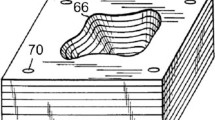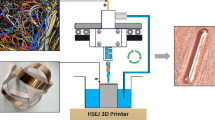Abstract
In this study, the parameters of a three-dimensional (3D) additive printing process of pure copper (Cu) without supports was investigated using localized electroplating with precisely controlled nozzle fluid dynamics. In addition, we analyzed the characteristics of inverse shape formations in relation to the main additive manufacturing factors, such as applied voltage, anode movement speed, and Z-axis rise per cycle. The length of the shape produced horizontal to the ground and size of the bottom stack, which can be used to inverse the shape via the radius, were confirmed and an optimum condition was investigated. Finally, the successful fabrication of complicated inverse tapered 3D structures, such as spiral rings, was demonstrated using the proposed method.







Similar content being viewed by others
References
Cohen A, Chen R, Frodis U et al (2010) Microscale metal additive manufacturing of multi-component medical devices. Rapid Prototyp J 16(3):209–215
Otton JM, Birbara NS, Hussain T et al (2017) 3D printing from cardiovascular CT: a practical guide and review. Cardiovasc Diagn Ther 7(5):507–526
Kain A, Mueller C, Reinecke H et al (2009) High aspect ratio-and 3D-printing of freestanding sophisticated structures. Procedia Chem 1(1):750–753
Macdonald E, Salas R, Espalin D et al (2014) 3D printing for the rapid prototyping of structural electronics. IEEE Access 2:234–245
Willis K, Brockmeyer E, Hudson S et al. (2012) Printed optics: 3D printing of embedded optical elements for interactive devices. In Proceedings of the 25th annual ACM symposium on User interface software and technology pp. 589–598.
Kanada Y (2015) 3D-printing plates without “support.” Int J Mater Metall Eng 9(5):629–635
Kwon DH (2015) Study on 3D printer suitable for character merchandise production training. Cartoon Animat Stud 41:455–486
Yang Y, Fuh JY, Loh HT et al (2003) Multi-orientational deposition to minimize support in the layered manufacturing process. J Manuf Syst 22(2):116
Jin J, Chen Y (2017) Highly removable water support for stereolithography. J Manuf Process 28:541–549
O’Bryan CS, Bhattacharjee T, Niemi SR et al (2017) Three-dimensional printing with sacrificial materials for soft matter manufacturing. MRS Bull 42(8):571–577
Tay YWD, Li MY, Tan MJ et al (2019) Effect of printing parameters in 3D concrete printing: printing region and support structures. J Mater Process Technol 271:261–270
Wu BM, Borland SW, Giordano RA et al (1996) Solid free-form fabrication of drug delivery devices. J Control Release 40(1–2):77–87
Katstra WE, Palazzolo RD, Rowe CW et al (2000) Oral dosage forms fabricated by three dimensional printingTM. J Control Release 66(1):1–9
Ezair B, Fuhrmann S, Elber G (2018) Volumetric covering print-paths for additive manufacturing of 3D models. Comput Aided Des 100:1–13
Kung C, Lee TH (2016) Selection of process parameters for the precision of screw-shaped objects on reprap 3-D printers. In 2016 International Symposium on Computer, Consumer and Control (IS3C), 972–975
Vanek J, Galicia JAG, Benes B (2014) Clever support: efficient support structure generation for digital fabrication. Comput Graph Forum 33(5):117–125
Hinton TJ, Hudson A, Pusch K et al (2016) 3D printing PDMS elastomer in a hydrophilic support bath via freeform reversible embedding. ACS Biomater Sci Eng 2(10):1781–1786
Saggiomo V, Velders AH (2015) Simple 3D printed scaffold-removal method for the fabrication of intricate microfluidic devices. Adv Sci 2(9):1500125
Bibb R, Eggbeer D, Williams R (2006) Rapid manufacture of removable partial denture frameworks. Rapid Prototyp J 12(2):95–99
Zhang X, Le X, Panotopoulou A, Whiting E et al (2015) Perceptual models of preference in 3D printing direction. ACM Trans Graph 34(6):1–12
Langelaar M (2016) Topology optimization of 3D self-supporting structures for additive manufacturing. Addit Manuf 12:60–70
Taylor RM, Niakin B, Lira N, et al. (2020) Design optimization, fabrication, and testing of a 3D printed aircraft structure using fused deposition modeling. In AIAA Scitech 2020 Forum 1924
Liu Y, Li Z, Wei P et al (2016) Generating support structures for additive manufacturing with continuum topology optimization methods. Rapid Prototyp J 25(2):232–246
Meng L, Zhang W, Quan D et al (2019) From topology optimization design to additive manufacturing: today’s success and tomorrow’s roadmap. Arch Comput Methods Eng 27:1–26
Kudzal AD, McWilliams BA, Taggart-Scarff J et al (2020) Fabrication of a low alloy ultra-high strength (> 1500 MPa yield) steel using powder bed fusion additive manufacturing. Mater Sci Eng A 770:138512
Leung CLA, Marussi S, Towrie M et al (2019) The effect of powder oxidation on defect formation in laser additive manufacturing. Acta Mater 166:294–305
Park HK, Na TW, Yang SM et al (2019) Thermodynamic analysis of oxygen refining during electron-beam additive manufacturing of pure titanium products. Mater Lett 236:106–108
Gasper AND, Hickman D, Ashcroft I et al (2019) Oxide and spatter powder formation during laser powder bed fusion of Hastelloy X. Powder Technol 354:333–337
Acknowledgements
This work was supported by the Korea Evaluation Institute of Industrial Technology grant funded by the Ministry of Trade and Industry (No.2018-10077278, Development of Metal Additive Manufacturing Machine using Electrochemical Deposition and Nozzle Fluid Dynamics).
Funding
This work was supported by the Korea Evaluation Institute of Industrial Technology grant funded by the Ministry of Trade and Industry (No.2018-10077278, Development of Metal Additive Manufacturing Machine using Electrochemical Deposition and Nozzle Fluid Dynamics).
Author information
Authors and Affiliations
Contributions
HK and YK are the first authors of this work and they performed most of experiments. Dr. SK is the director of this work and verified all of data. Dr. BY and Dr. SY are the main organizer and advisor of this work.
Corresponding authors
Ethics declarations
Conflict of interest
Author Y. Kim, H. Kim were employed by the company Anycasting. The remaining authors declare that the research was conducted in the absence of any commercial or financial relationships that could be construed as a potential conflict of interest.
Additional information
Publisher's Note
Springer Nature remains neutral with regard to jurisdictional claims in published maps and institutional affiliations.
Rights and permissions
About this article
Cite this article
Kim, H.R., Kim, Yk., Yoo, B. et al. Factors influencing the deposition of the inverse shape of 3D metal printing using electrochemical deposition. Prog Addit Manuf 7, 315–324 (2022). https://doi.org/10.1007/s40964-021-00231-0
Received:
Accepted:
Published:
Issue Date:
DOI: https://doi.org/10.1007/s40964-021-00231-0




